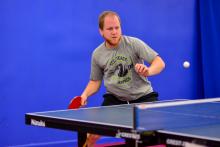After surveying dozens of club players across the country regarding game strategy, there is one common strategy used across the board. Most players work the point from corner to corner. Most players start off by playing against their opponents’ backhands. If that doesn’t work, then they play to the wide forehand then back to the backhand.
Only about 10% of the club players focus on playing the ball to their opponents’ middle. When I use the term middle, I do not mean the white center line. The middle is the transition point between the forehand and backhand; this zone can really vary in location from player to player.
If you hit the ball to your opponent’s backhand, he will usually react with a backhand, without thinking. If you hit the ball to your opponent’s forehand, he will usually react with a forehand, without thinking. Both of those strokes flow naturally. However, when you hit the ball to your opponent’s middle, he needs to make a quick decision, choose backhand or forehand, move into position, play the correct timing, then hit the ball. Once your opponent needs to make a “decision” his shot consistency and quality will be much worse. Even if he makes the shot on, it probably won’t be quite as strong.
There are several drills that I do to help me play against my opponent’s middle and help me when he plays against my middle. Let me give you an example of one of the drills…
In this drill, player A blocks with his backhand against player B’s middle.
The drills starts with player A serving the ball to players B’s middle and player B attacking with his forehand or backhand. If player B attacks with his backhand, then player A will then block the next ball slightly more to the forehand side. If player B attacks with his forehand, then player A will block slightly more to the forehand. Player A’s goal is to force player B to feel uncomfortable by making him move and alternate between backhands and forehands. Player B’s goal is to watch player A’s racket, adjust with his feet, and maintain consistent attacks throughout the rally.
This same drill can be used by a blocker with the looper trying to pin the blocker at the transition point. After mastering the middle, the entire game will seem much easier and you will be able to flow from stroke to stroke with a smoother transition.
Are You in a Jam?

Learn a New Strategy!
Category:



